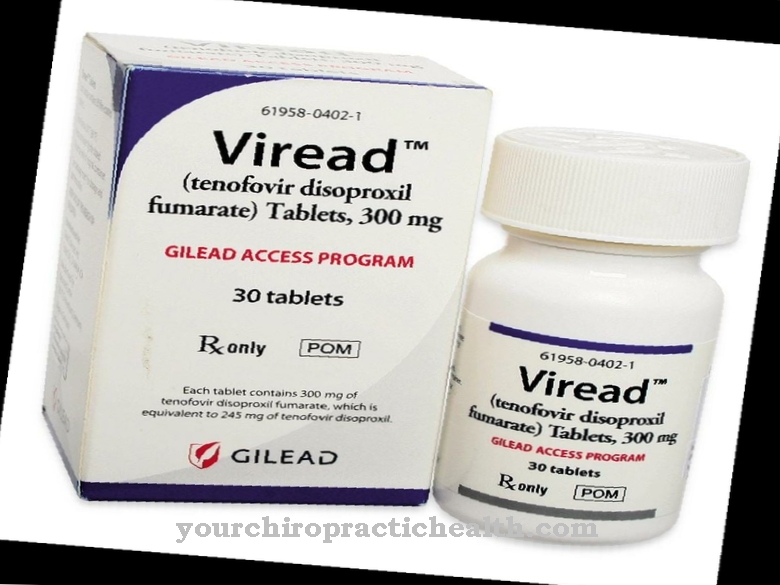With the medicinal substance Tipranavir is a drug that is used to treat people with type 1 HIV. It is used as part of an antiretroviral combination therapy. The drug Tipranavir is available on the pharmacological market under the trade name Aptivus® and is distributed by the manufacturer Boehringer. The active ingredient tipranavir belongs to the category of HIV protease inhibitors.
What is tipranavir?
The drug tipranavir is an antiviral agent that belongs to the pharmacological category of HIV protease inhibitors. From a structural point of view, however, it differs from other substances that also belong to this group.
The active ingredient tipranavir is primarily used for drug therapy for HIV infections. The effect of the drug is due to the fact that it affects the so-called viral protease. This protease is essential for viruses to multiply.
The active ingredient is usually administered orally in the form of capsules. The drug is administered twice a day together with meals. In the majority of cases, the drug tipranavir is taken together with the booster ritonavir. This substance is a so-called CYP inhibitor, which slows down the breakdown of tipranavir. This mechanism improves the effectiveness of the drug tipranavir.
However, various side effects are possible while taking it. The most common are nausea, headache, and fatigue. It should also be noted that the substance may be toxic to the liver and, in some cases, cause hepatitis or other serious diseases of the liver. For this reason, strict medical control is required.
The drug tipranavir was approved in Europe and the US in 2005. Tipranavir usually appears white or slightly yellow in color. The structure of the active substance tipranavir is non-peptide. Basically, the drug tipranavir is an anti-viral drug that is usually combined with other types of anti-viral drugs.
Pharmacological effect
The special mode of action of the drug tipranavir is responsible for making it suitable for treating people with HIV-1. In principle, the substance tipranavir is an HIV protease inhibitor that inhibits a special viral enzyme. This enzyme is essential for the virus to multiply and produce new viruses. As the viral protease is impaired by the active ingredient tipranavir, the viruses are no longer able to multiply further undisturbed. As a result, the viral load for the affected patient is reduced and the virus is hindered from spreading in the human organism.
The problem, however, is that the viruses can quickly develop resistance to the drug tipranavir. Unlike other HIV protease inhibitors, the drug does not have a peptide structure. Thus it forms the first type of non-peptide HIV protease inhibitor. These structural differences are probably responsible for the fact that treatment with the drug tipranavir leads to less cross-resistance than with other peptide protease inhibitors. In this way, the drug tipranavir is also effective against HIV strains that are already resistant to other drugs.
Research studies indicate that the drug tipranavir is significantly more effective in such HIV strains. After oral ingestion, the active ingredient binds to more than 90 percent of the proteins in the plasma of the blood.
Most of the drug is then metabolized in the liver. The so-called cytochrome P450 system is primarily responsible for metabolism and breakdown. Finally, the active ingredient is excreted in the stool. Tipranavir has an average half-life of around five to six hours.
Medical application & use
The drug tipranavir is usually used to treat patients who are infected with the type 1 HIV virus. The active ingredient tipranavir is mainly used when the affected person has already developed resistance to other HIV protease inhibitors.
However, since serious side effects are possible from taking the drug tipranavir, it is only approved for special conditions. A combination of the drug tipranavir with ritonavir is also recommended.
Risks & side effects
Although the drug tipranavir is more effective than other HIV protease inhibitors, the likelihood of undesirable side effects is increased. The most common side effects include nausea, diarrhea, abdominal pain and headache. Rashes on the skin are also possible.
If tipranavir is combined with ritonavir, it may be toxic to the liver. Patients with disorders of the liver function are therefore not suitable for therapy with the active ingredient tipranavir.
Other potential side effects are, for example, hypersensitivity reactions to the active ingredient, thrombocytopenia, neutropenia, metabolic disorders, sleep disorders and dizziness.
Various interactions with other substances must also be taken into account. In order to avoid interactions, for example, simultaneous use of rifampicin, simvastatin and lovastatin should not be used. Oral contraceptives and some benzodiazepines are also unsuitable for combination with the drug tipranavir. The doctor should be informed of any side effects.



























